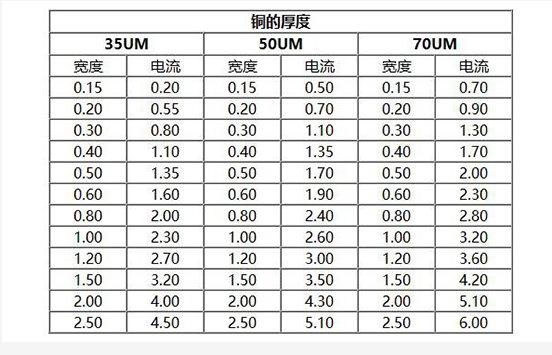PCB copper foil thickness specification and its relationship with current
There are three thickness specifications of PCB copper foil: 35um, 50um, 70um. The relationship between the thickness of the copper foil of the PCB board and the current is shown in the following figure:

*Note: When using copper foil as a conductor to pass large currents, the current carrying capacity of the copper foil width should be selected with reference to the value in the above figure with a 50% derating.
1. If possible, use a separate power layer and ground layer as much as possible when supplying power. In order to achieve the purpose of equalizing current and reducing noise, when using a source network bus, the bus should be as wide as possible, and the more meshes, the better, forming many nested meshes.
2. Do not make the power traces thin in the middle and thick at the ends to prevent too much voltage drop on them. It is best to use arc-shaped routing when routing. Do not make sudden turns. Use obtuse turns greater than 90°. If conditions permit, you can add filter capacitors at the vias.
3. Use a ground wire to surround the parts that are particularly prone to noise to prevent the noise from coupling into the voltage.
The calculation method of the width of the copper thickness of the PCB and the amount of current flowing:
The thickness of the copper foil of the PCB board is generally 35um, when the line width is 1mm, the cross-sectional area of the line is 0.035 square millimeters, and the current density is usually 30A/square millimeter, so 1A current can flow per millimeter of line width.
The following is the IPC275-A standard calculation formula. It is related to temperature rise, copper foil thickness and A.
I = 0.0150(DT 0.5453)(A 0.7349) for IPC-D-275 Internal Traces
I = 0.0647(DT 0.4281)(A 0.6732) for IPC-D-275 External Traces
The specific conversion method of the thickness of the copper foil of the PCB board:
1 British sigh (ft) = 12 British hours (in)
1 inch (inch) = 1000 mils (mil) mils (mil) sometimes become British silk
1 mil (mi1) = 25.4 microns (um)
1 mil (mil) = 1000 micro inches (uin) Some companies call micro inches as wheat
lum=40uin
1OZ=28.35 g/square foot 2 35 microns
1 ounce (oz) = 0.0625 pounds such as (pb)
1 pound (pb) = 454 grams (g)
1 inch (in) = 2.54 centimeters (cm)
1 mil (mil) = 0.001 inch hour (in)
The above is the relevant knowledge of PCB copper foil thickness specifications, I hope it will be helpful to you!
iPCB is a high-tech manufacturing enterprise focusing on the development and production of high-precision PCBs. iPCB is happy to be your business partner. Our business goal is to become the most professional prototyping PCB manufacturer in the world. Mainly focus on microwave high frequency PCB, high frequency mixed pressure, ultra-high multi-layer IC testing, from 1+ to 6+ HDI, Anylayer HDI, IC Substrate, IC test board, rigid flexible PCB, ordinary multi-layer FR4 PCB, etc. Products are widely used in industry 4.0, communications, industrial control, digital, power, computers, automobiles, medical, aerospace, instrumentation, Internet of Things and other fields.